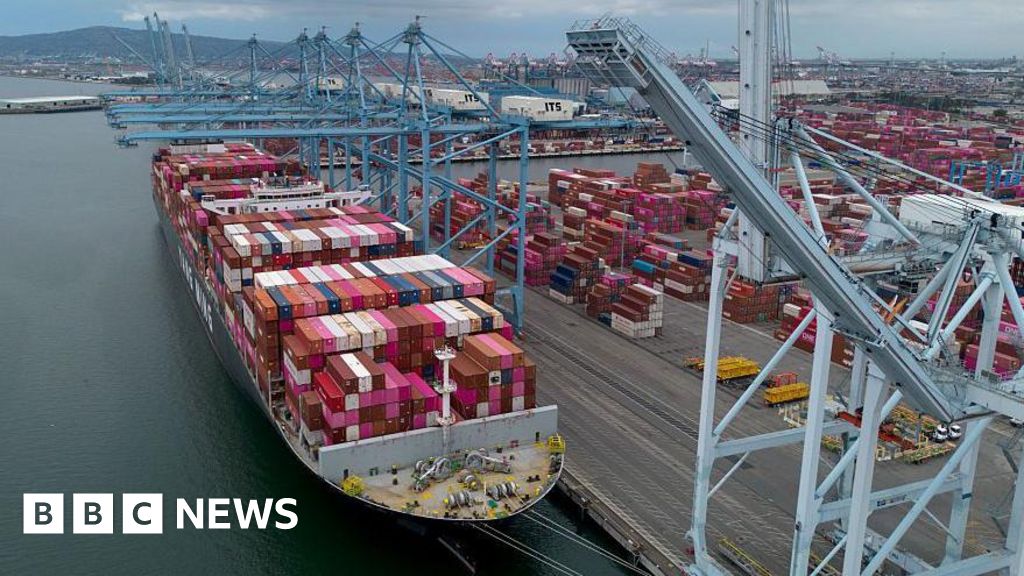ARTICLE AD BOX
Bristol: Fastest driving simulator sold to McLaren
By Dave Harvey
Business and Environment Correspondent, BBC West
A small engineering firm has developed a driving simulator which could save car manufacturers "millions".
The simulator is said to be so realistic that car makers can test new models on the virtual system without making expensive prototypes.
Motorsport engineer Ash Warne started Dynisma simulators in a small village close to Bristol in 2017.
He has just signed an exclusive deal to supply McLaren Automotive, the British supercar company.
Steve Sutcliffe, an experienced motoring journalist, predicted that the new simulator "will save car manufacturers tens of millions of pounds".
The simulator cockpit has a wrap-around screen to simulate movement
So how quick is it, and can a tiny company working out of a farmyard close to the city really take on the world of Formula 1?
In the exclusive world of supercars and F1, everything is measured in milliseconds.
Racing drivers can respond to something happening on the track in 100 milliseconds, that's just one tenth of a second.
But if a driver is in a simulator, the machine needs time to react as well.
When the driver hits the brakes, turns the steering wheel, or floors the accelerator, the simulator's computers have a lot of work to do. The cockpit holding the driver is lifted on hydraulic rams to simulate precisely how a car corners. The wrap around screen, or virtual reality goggles, respond to show the track screeching past at hundreds of miles an hour.
The simulator can react to what the driver does in three milliseconds
All this takes time. Most simulators on the market lag the action by 30-40 milliseconds. This might not seem much, but it makes the ride feel "less real", according to experienced drivers.
Crucially, if the car is cornering badly, for instance, it is hard to know if it is actually the car's fault, or just the simulator playing catch-up.
In the Dynisma simulator, the lag is not 30 milliseconds, but just three.
"It is incredible," said Steve Sutcliffe, after testing it.
Image source, Auto Express
Image caption,Steve Sutcliffe tested the simulator for Auto Express
Mr Sutcliffe is a veteran motorsport journalist. He has driven "quite a few racing cars" over the years, and countless road cars.
He recently tested the simulator set up for a F1 car, for Auto Express and the specialist motoring magazine The Intercooler.
"And no," he said, "it is not exactly like driving a real car on a real road. But it is super super close."
Virtual test-tracks
F1 teams have used simulators to train drivers for years, but that is not what this one is for.
It is for car designers and engineers. Until recently, every time a car was designed, companies had to make a real life prototype, in cold metal.
Then big teams would take them out onto real roads, and drive them hard to test the set-up.
It is expensive process, and the new simulator can replace it, much more cheaply.
Ash Warne employs more than 75 people at his manufacturing centre south of Bristol
Ash Warne said: "Manufacturers can run through a whole series of tests in one day that would take many months and millions of pounds if they had to make a prototype in the real world."
McLaren has bought the simulator, and signed a partnership deal to develop further refinements.
Mark Salmon is McLaren's Principle Engineer for Advanced Virtual Engineering.
He told me: "We're able to explore new ideas - including those that exist only as concepts - quickly and efficiently in the virtual world without using real-world resources."
Image source, McLaren
Image caption,McLaren will use the simulator to test new prototypes on virtual tracks
"And when we're developing a new technology or feature - or even a whole new vehicle - we can test and evaluate different scenarios instantly, pushing the boundaries of what's possible."
There are limits, though, to this technology.
Manufacturers will still have to make real prototypes, but much later in the development process. In time, McLaren hope to cut out real-life prototyping altogether, when the simulators are accurate enough.
'Smart Manufacturing'
Meanwhile the car industry is now radically redesigning every car. The roll-out of battery electric vehicles is changing the fundamental design of vehicles.
Using simulators, engineers can experiment with new solutions quickly and cheaply.
Steve Sutcliffe thinks this is the really significant change that simulators are bringing.
"Instead of pounding out tens of thousands of miles in prototypes, they can do it in these simulators," he said.
"It's going to save the manufacturers millions, tens of millions of pounds. It will transform the industry."
Jim Davison of Make UK believes 'Smart Manufacturing' is the way for British firms to compete
It is not just the car industry using digital technology to replace physical production. What experts call smart manufacturing is a growing trend.
"It's vital for British manufacturers," says Jim Davison.
Mr Davison is the Southern Director for the manufacturers' trade organisation, Make UK.
He believes British companies must invest in advanced technology like the car simulator, or robotic assembly lines, to compete globally.
He said: "One of the biggest challenges UK companies face is the shortage of labour. There are 70,000 unfilled vacancies in manufacturing right now. So we just don't have the people, and that is common to all western economies.
"So it's not a case of robots taking jobs, it is more robots taking the unfilled vacancies."
In Barrow Gurney, the success of their supercar simulator has created over 75 jobs already. With export sales growing, they hope their new deal with one of the top names of British motorsport will bring even more work.
Follow BBC Bristol on Facebook, X and Instagram. Send your story ideas to us on email or via WhatsApp on 0800 313 4630.

 1 year ago
905
1 year ago
905








 English (US) ·
English (US) ·